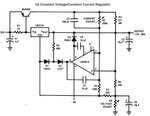matbob
Full Member level 2
Dear All,
I would be really happy if someone could explain how the circuit: 5A Constant Voltage/Constant Current Regulator given in the LM317 datasheet works. I have built this circuit and it works like a charm. Really good circuit for experiment purposes.
Circuit:

What are the purposes of R4, R7, D2, C5?
Is the LED for indication purpose only?
I would be really happy if someone could explain how the circuit: 5A Constant Voltage/Constant Current Regulator given in the LM317 datasheet works. I have built this circuit and it works like a charm. Really good circuit for experiment purposes.
Circuit:

What are the purposes of R4, R7, D2, C5?
Is the LED for indication purpose only?